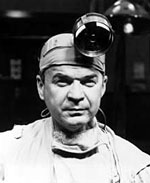|
6. Open heart surgery is safe and successful, thanks to pioneering research at the University's Medical School

| Dr. C Walton Lillehei performed the first open heart surgery at the University of Minnesota in 1952. Lillehei has been called the "King of Hearts" for his pioneering research as a surgeon and inventor of medical devices.
See a slide show illustrating his career
(Photo courtesy of University of Minnesota)
|
In the 1950s, the University of Minnesota was the focal point of research into open heart surgery and the development of medical devices such as heart-lung machines and pacemakers. The first open heart surgery was performed in September, 1952 by Dr. C. Walton Lillehei and Dr. F. John Lewis.
Lillehei has been called the "King of Hearts" for his pioneering research as a surgeon and inventor of medical devices. He also trained many of the world's leading heart surgeons, including Dr. Christiaan Barnard, who performed the first heart transplant.
Lillehei, a native of Minneapolis, graduated from the U of M's Medical School in 1942. After serving in World War II, he returned to the university, and began working under the direction of chief surgeon Owen Wangensteen. (Wangensteen was a medical pioneer in his own right. He developed the Wangensteen suction, which was
designed to treat the nearly always fatal condition of intestinal blockage. The Wangensteen suction tube remains one of the most commonly-used surgical instruments.)
Lillehei's work focused on helping patients with heart defects, many of whom were in poor health and died at an early age as a result of their condition. Lillehei conducted a series of experiments on dogs to develop methods to repair such defects. He was then ready to try his techniques on humans.
On September 2, 1952, Lillehei and Lewis operated on a five-year old girl to correct a heart defect. The operation was a success, and the girl went home 11 days afterward. It was the first surgery to be performed on the open heart under direct vision. During these same years, open heart surgery had been tried at a number of eastern hospitals, but their results were disappointing.
One problem that Lillehei and his colleagues had to solve was how to keep a patient's blood flowing and receiving oxygen, while reducing the blood flow to the heart to allow the surgeon a clear field of vision. With the first patients, they induced hypothermia - cooling the patient's body dramatically for short periods of time. Later, they experimented with cross-circulation; using a healthy adult's body to filter the patient's blood. Although the technique worked successfully for dozens of patients, it was quite controversial among other physicians at the hospital. Eventually, Lillehei worked with a colleague, Dr. Richard De Wall, to develop the first mechanical blood oxygenator, which was used for the first time in 1955.
As he continued to refine his surgical techniques, Dr. Lillehei's patients survived open heart surgery at higher and higher rates. But one frequent complication was heart block - irregular heart beat - which developed during surgery or afterward, and the condition was often fatal. Dr. Lillehei and his colleagues began experimenting with using electric shocks to restore normal heart beats. That experimentation led to the development of pacemakers, devices which deliver low dosage electric shocks to keep the heart in rhythm. The first pacemakers were used in 1957. They restored normal heart rhythm during surgery, and later were modified for use after surgery as well.
"What mankind can dream, research and technology can achieve."- Dr. C. Walton Lillehei
|
The first pacemakers were large machines which needed to be plugged into an outlet, so patients had no mobility while using one. Dr. Lillehei collaborated with an electrical engineer and part-time TV repairman, Earl Bakken, to design pacemakers which were battery-operated, portable, and eventually, implantable. Bakken and his brother-in-law, Palmer Hermundslie, began developing and producing these pacemakers in their garage in the late '50s. They incorporated their business in 1958 under the name Medtronic, Inc. Medtronic, based in Minneapolis, is now the world's largest medical technology company, with annual sales of more than $5 billion.
In later years, Dr. Lillehei continued to work on improving surgical techniques, and in developing new devices to aid heart patients. He helped design the first mechanical heart valve, which became a leading producer for St. Jude Medical, Inc. Lillehei served as medical director at St. Jude Medical for 20 years until his death from cancer in July, 1999. He was 80.
Dr. Lillehei's widow, Katherine, has given the University of Minnesota's Medical School $13 million to create the Lillehei Heart Institute, to promote new therapies for patients with heart disease. The university is hoping to raise a total of $25 million to fund the Institute.
|